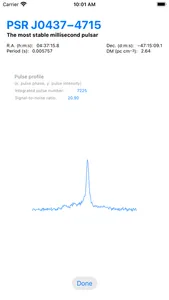The Radio Pulsars app simulates your iPhone observing pulsars as a radio telescope. With it, you first experience real pulsar observations.
Pulsars are one of the many astronomical phenomena. They are believed to be rapidly spinning neutron stars with extremely precise periods. Due to the ultra high magnetic fields at the poles, neutron stars power charged particles, which then produce electromagnetic emission within narrow beams. Every time an emission beam sweeps us, we see a pulse. Pulsars are "lighthouses" in the universe!
Pulsars are very far away from us, and they appear as weak sources. A single pulse usually drowns into noises and cannot be seen. Astronomers add or integrate hundreds or thousands of single pulses together to increase the signal-to-noise ratio. The integrated pulse profiles are different from pulsars to pulsars; they are pulsars' fingerprints!
Pulsar emission covers the whole spectra, from radio, infrared, optical, and all the way up to gamma-ray. With around 3,000 known, radio pulsars show the largest population. Radio Pulsars now incorporates 83 pulsars, with these famous guys: PSR J1921+2153 the first pulsar known detected in 1967, PSR J0534+2200 the pulsar in the Crab nebula, PSR J0835-4510 the brightest pulsar known, PSR J0437-4715 the most stable pulsar known, PSR J0332+5434 the brightest pulsar in the northern sky, PSR J0737-3039 the unique double pulsar system, and PSR J1915+1606 the pulsar-neutron star system.
Please note Radio Pulsars now only supports iPhone and does not support iPad.
Pulsars are one of the many astronomical phenomena. They are believed to be rapidly spinning neutron stars with extremely precise periods. Due to the ultra high magnetic fields at the poles, neutron stars power charged particles, which then produce electromagnetic emission within narrow beams. Every time an emission beam sweeps us, we see a pulse. Pulsars are "lighthouses" in the universe!
Pulsars are very far away from us, and they appear as weak sources. A single pulse usually drowns into noises and cannot be seen. Astronomers add or integrate hundreds or thousands of single pulses together to increase the signal-to-noise ratio. The integrated pulse profiles are different from pulsars to pulsars; they are pulsars' fingerprints!
Pulsar emission covers the whole spectra, from radio, infrared, optical, and all the way up to gamma-ray. With around 3,000 known, radio pulsars show the largest population. Radio Pulsars now incorporates 83 pulsars, with these famous guys: PSR J1921+2153 the first pulsar known detected in 1967, PSR J0534+2200 the pulsar in the Crab nebula, PSR J0835-4510 the brightest pulsar known, PSR J0437-4715 the most stable pulsar known, PSR J0332+5434 the brightest pulsar in the northern sky, PSR J0737-3039 the unique double pulsar system, and PSR J1915+1606 the pulsar-neutron star system.
Please note Radio Pulsars now only supports iPhone and does not support iPad.
Show More



